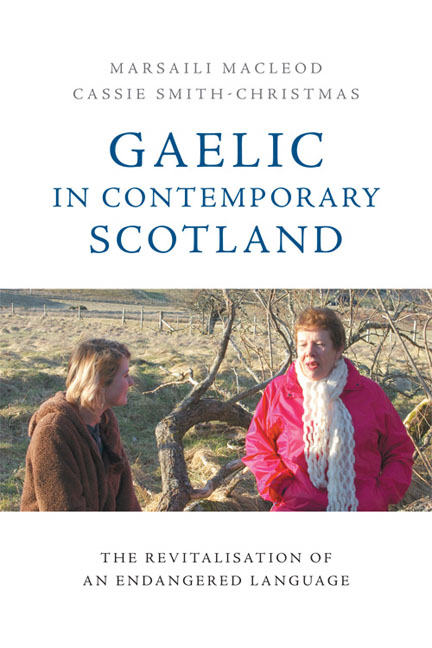Book contents
- Frontmatter
- Contents
- List of Figures
- List of Tables
- Notes on Contributors
- Foreword: Assailed yet Resolute
- Acknowledgements
- List of Abbreviations
- 1 Introduction
- 2 The Language of the Playground: Activists Building Consensus on the Language Policy and Ethos of a New Gaelic Immersion School
- 3 Mismatches between National and Local Gaelic Development: Cròileagan Dùn Èideann and the Promotion of Gaelic-medium Education
- 4 Gaelic amongst Schoolchildren: Ideas on Language Change and Linguistic Choices in Gaelic
- 5 When School is Over and Done With: Linguistic Practices and Sociodemographic Profiles of Gaelic-medium Educated Adults
- 6 New Speakers of Gaelic: A Historical and Policy Perspective
- 7 Learning Gaelic in Adulthood: Second Language Learning in Minority Language Contexts
- 8 Dlùth is Inneach: Charting Language Ideology in the Contemporary Gaelic World
- 9 Gaelic Language Use in Public Domains
- 10 Planning for Growth: The Professionalisation of the Taskforce for Gaelic Revitalisation
- 11 Organisational Language Planning: Gaelic Language Plans in the Public Sector
- 12 The Future of Gaelic Language Revitalisation in Scotland
- Index
11 - Organisational Language Planning: Gaelic Language Plans in the Public Sector
Published online by Cambridge University Press: 18 December 2019
- Frontmatter
- Contents
- List of Figures
- List of Tables
- Notes on Contributors
- Foreword: Assailed yet Resolute
- Acknowledgements
- List of Abbreviations
- 1 Introduction
- 2 The Language of the Playground: Activists Building Consensus on the Language Policy and Ethos of a New Gaelic Immersion School
- 3 Mismatches between National and Local Gaelic Development: Cròileagan Dùn Èideann and the Promotion of Gaelic-medium Education
- 4 Gaelic amongst Schoolchildren: Ideas on Language Change and Linguistic Choices in Gaelic
- 5 When School is Over and Done With: Linguistic Practices and Sociodemographic Profiles of Gaelic-medium Educated Adults
- 6 New Speakers of Gaelic: A Historical and Policy Perspective
- 7 Learning Gaelic in Adulthood: Second Language Learning in Minority Language Contexts
- 8 Dlùth is Inneach: Charting Language Ideology in the Contemporary Gaelic World
- 9 Gaelic Language Use in Public Domains
- 10 Planning for Growth: The Professionalisation of the Taskforce for Gaelic Revitalisation
- 11 Organisational Language Planning: Gaelic Language Plans in the Public Sector
- 12 The Future of Gaelic Language Revitalisation in Scotland
- Index
Summary
The Gaelic Language (Scotland) Act 2005 (the ‘Act’) is the single most important piece of legislation to have been enacted in support of the Gaelic language. Passed by the Scottish Parliament on 21 April 2005, it received Royal Assent on 1 June of that year, and came into force on 13 February 2006. The Act created a dedicated language planning body, Bòrd na Gàidhlig (the ‘Bòrd’), and a mechanism, Gaelic language plans, by which potentially all Scottish public authorities – essentially, the wider public sector subject to regulation by Scotland's devolved institutions, as well as those institutions themselves – can be subjected to obligations in relation to their use of, and policy for, the Gaelic language. In this respect, the Act replicated the approach taken in Wales in the Welsh Language Act 1993 and in the Republic of Ireland in the Official Languages Act 2003, in which language plans, or ‘schemes’, to use the term employed in those two pieces of legislation, were central. Before the Act, public authorities in Scotland were under no obligation to use Gaelic in dealing with the public or to provide other support for the language, although a small number of such bodies, including Comhairle nan Eilean Siar (CNES), the local authority for the Outer Hebrides, the Highland Council and the Scottish Executive (as the Scottish Government was called prior to 2007), had voluntarily adopted policies on these matters.
Both domestic legislation and international legal standards in relation to minor-ity languages can have a variety of aims. In some cases, the aim is political: relations between the linguistic minority and the majority can be a source of tensions which can lead to instability, secessionist movements and, in extreme cases, violence, and in such circumstances legislation can be intended to assuage such tensions. In some cases – particularly those in which significant numbers of members of the linguistic minority are unable to communicate in the majority or official language – legal meas-ures are motivated by equality considerations: provision of minority language services facilitates equal access to such services for members of the minority who are unable to communicate effectively in the majority or official language. And, often, the aim is the revitalisation of the minority language.
- Type
- Chapter
- Information
- Gaelic in Contemporary ScotlandThe Revitalisation of an Endangered Language, pp. 156 - 172Publisher: Edinburgh University PressPrint publication year: 2018

